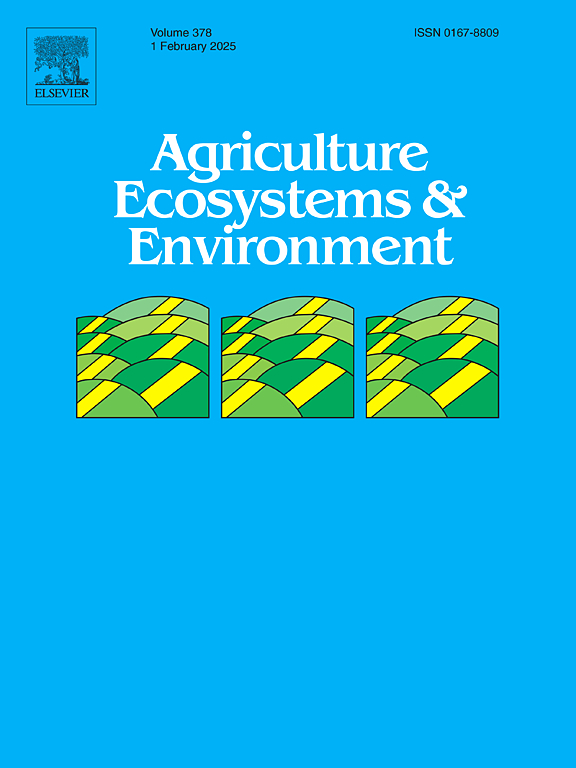揭示葡萄园行间植被对南非土壤生物多样性的影响
IF 6
1区 农林科学
Q1 AGRICULTURE, MULTIDISCIPLINARY
引用次数: 0
摘要
为了实现可持续葡萄栽培,建议农民保持行间植被覆盖,以促进生态平衡。然而,行间植被对土壤生物多样性和相关生态系统功能的影响程度仍然是一个悬而未决的问题。本研究探讨了不同葡萄园行间植被管理方式对土壤动物多样性、组成和功能结构的影响。这项研究是在南非西开普省Stellenbosch地区的24个地点进行的。比较了三种处理:裸地(没有植被)、覆盖地(允许植被生长)和自然地(作物区外的自然植被)。天然植被和覆被葡萄园的物种多样性和营养动物比例显著高于光秃秃的葡萄园。植被覆盖对土壤动物多样性有积极的影响,特别是对蜘蛛、腐食动物、杂食动物和捕食动物等功能类群有积极的影响。植被覆盖度对草食动物有负面影响,表明植被覆盖度高的葡萄园草食动物较少。凋落物覆盖是影响土壤动物多样性和组成的主要变量,强调了在葡萄园中保持有机质的重要性。研究还表明,植物物种丰富度对蚂蚁物种多样性有负面影响,可能是由于对资源的竞争加剧。相比之下,蜘蛛受到凋落物覆盖的积极影响,这可能有助于捕获猎物并减少土壤干扰。本研究结果强调了植被管理对保持葡萄园土壤动物多样性和组成的重要意义。结果表明,被覆盖的葡萄园可以支持更多样化的土壤动物,这有助于生态系统服务。总的来说,这项研究强调了采用可持续葡萄园管理实践的重要性,优先考虑土壤动物保护和生物多样性。本文章由计算机程序翻译,如有差异,请以英文原文为准。
Unravelling the effects of vineyard inter-row vegetation on soil biodiversity in South Africa
For sustainable viticulture it is suggested that farmers maintain vegetation cover in inter-rows to promote ecological balance. However, the extent to which inter-row vegetation influence soil biodiversity and associated ecosystem functions remains an open question. This study explored how different vineyard inter-row vegetation management practices influence soil fauna diversity, composition and functional structure. The research was conducted across 24 sites in the Stellenbosch area, Western Cape, South Africa. Three treatments were compared: bare (no vegetation), covered (vegetation allowed to grow), and natural (natural fynbos vegetation outside of the crop areas). Natural vegetation and covered vineyards had significantly higher species diversity and proportion of detritivores compared to bare vineyards. Vegetation cover had a positive influence on soil fauna diversity, particularly for spiders, and functional groups such as detritivores, omnivores, and predators. However, herbivores were negatively affected by vegetation cover, suggesting that vineyards with higher vegetation cover may have fewer herbivores. Litter cover was the primary variable influencing soil fauna diversity and composition, highlighting the importance of retaining organic matter in vineyards. The study also shows that plant species richness had a negative impact on ant species diversity, possibly due to increased competition for resources. In contrast, spiders were positively affected by litter cover, which may have facilitated prey trapping and reduced soil disturbance. The findings of this study emphasize the significance of vegetation management in maintaining soil fauna diversity and composition in vineyards. The results suggest that covered vineyards can support a more diverse range of soil fauna, which can contribute to ecosystem services. Overall, this study highlights the importance of adopting sustainable vineyard management practices that prioritize soil fauna conservation and biodiversity.
求助全文
通过发布文献求助,成功后即可免费获取论文全文。
去求助
来源期刊

Agriculture, Ecosystems & Environment
环境科学-环境科学
CiteScore
11.70
自引率
9.10%
发文量
392
审稿时长
26 days
期刊介绍:
Agriculture, Ecosystems and Environment publishes scientific articles dealing with the interface between agroecosystems and the natural environment, specifically how agriculture influences the environment and how changes in that environment impact agroecosystems. Preference is given to papers from experimental and observational research at the field, system or landscape level, from studies that enhance our understanding of processes using data-based biophysical modelling, and papers that bridge scientific disciplines and integrate knowledge. All papers should be placed in an international or wide comparative context.
 求助内容:
求助内容: 应助结果提醒方式:
应助结果提醒方式:


